ROBERTS RULES
OF ORDER
NEWLY REVISED
ROBERTS RULES
OF ORDER
NEWLY REVISED
11TH EDITION

GENERAL HENRY M. ROBERT
U.S. Army
A New and Enlarged Edition by
SARAH CORBIN ROBERT
HENRY M. ROBERT III
WILLIAM J. EVANS
DANIEL H. HONEMANN
THOMAS J. BALCH
with the assistance of
DANIEL E. SEABOLD
SHMUEL GERBER

DA CAPO PRESS
A Member of the Perseus Books Group
Copyright 1970, 1981, 1990, 2000, 2011 by Henry M. Robert III, Trustee for the Roberts Rules Association
Copyright 1943, 1951 by Isabel H. Robert
Copyright 1876, 1893, 1904, 1915, 1918, 1921 by Henry M. Robert
All rights reserved. No part of this publication may be reproduced, stored in a retrieval system, or transmitted, in any form or by any means, electronic, mechanical, photocopying, recording, or otherwise, without the prior written permission of the authors. All permission requests should be sent directly to: John Robert Redgrave, Authors Agent, Roberts Rules Association, 7377 Brodie Court, Sarasota, Florida 34238.
Cataloging-in-Publication Data is available from the Library of Congress
ISBN 978-0-306-82021-2 (hardcover)
978-0-306-82020-5 (paperback)
978-0-306-82022-9 (leatherbound)
Library of Congress Control Number: 2011932260
For questions and answers and further information on parliamentary procedure visit www.robertsrules.com
Da Capo Press is a member of the Perseus Books Group.
Find us on the World Wide Web at www.dacapopress.com
Da Capo Press books are available at special discounts for bulk purchases in the U.S. by corporations, institutions, and other organizations. For more information, please contact the Special Markets Department at the Perseus Books Group, 2300 Chestnut Street, Suite 200, Philadelphia, PA 19103, or call (800) 810-4145, ext. 5000, or e-mail .
Text design by Rachel Hegarty
Set in 9.5-point Galliard by Eclipse Publishing Services
First printing of the 11th edition, September 2011
1 2 3 4 5 6 7 8 9 10 16 15 14 13 12 11
Where there is no law, but every man does what is right in his own eyes, there is the least of real liberty.
HENRY M. ROBERT
It is difficult to find another branch of knowledge where a small amount of study produces such great results in increased efficiency in a country where the people rule, as in parliamentary law.
HENRY M. ROBERT
.jpg)
Inclusive of Roberts Rules of Order and Roberts Rules of Order Revised More Than Five and a Half Million Copies in Print
CITE THIS BOOK
with page and line numbers as in the following example:
RONR (11th ed.), p. 449, ll. 1214
This Eleventh Edition supersedes all previous editions and is intended automatically to become the parliamentary authority in organizations whose bylaws prescribe Roberts Rules of Order, Roberts Rules of Order Revised, Roberts Rules of Order Newly Revised, or the current edition of any of these titles, or the like, without specifying a particular edition. If the bylaws specifically identify one of the ten previous editions of the work as parliamentary authority, the bylaws should be amended to prescribe the current edition of Roberts Rules of Order Newly Revised (see p. 588).
ABBREVIATIONS IN THIS BOOK
| () | A boldface number, usually enclosed in parentheses, refers to a section number (here section 13). Section numbers appear at the top of each page, preceded by the symbol . |
| cf. | Compare to (confer) |
| e.g. | For example (exempli gratia) |
| ff. | And the pages immediately following the given page |
| l., ll. | Line, lines |
| p., pp. | Page, pages |
| tinted p. | The pages toward the end of this book with Charts, Tables, and Lists, which are separately paginated and are marked with gray on their outer edges, are referred to as tinted pages. |
Also see pages 11920, Notes on Example Format Throughout the Book.
CONTENTS
11Postpone Indefinitely
(To drop the main motion without a direct vote on it)
18Call for the Orders of the Day
(To demand to take up the proper business in order)
Tinted pages following page 670
to the Eleventh Edition
This Eleventh Edition of Roberts Rules of Order Newly Revised (RONR) is issued one hundred thirty-five years after the 1876 publication, by then-Major (later Brigadier General) Henry M. Robert, of the first in the series of books familiarly known as Roberts Rules of Order. A complete list of the editions is shown on page vi, and their history is told in the Introduction.
This Eleventh Edition in the entire series is the fifth edition of the second complete reworking of the subject matter first published in 1970. It is the only book in print containing the completely developed body of rules understood as Roberts Rules of Order.
In the decade since the publication of the Tenth Edition at the turn of the millennium, three important resources have been added to supplement RONR.
First, for some time there has been a felt tension between the need for a parliamentary manual lengthy enough to provide rules as comprehensive and unambiguous as possible so as to cover the great number and variety of parliamentary issues that may arise in a deliberative assembly, on the one hand, and the desirability of a book simple and straightforward enough to allow the ordinary meeting-goer easily to learn and use the basic rules that are sufficient for most meetings, on the other hand.
When this book last underwent complete revision in 1970, a concerted effort was made to enhance the value of the work for the study of parliamentary lawto the extent consistent with its primary purpose as a reference manual. For those who will brave it, it is written to serve as a self-explanatory text that can be read through, with topics presented in an order that will best convey an overall understanding of the subject matter. Nevertheless, it is recognized that this project may be a bigger challenge than many newcomers to parliamentary procedure will find themselves at first able or willing to take on.
In 2005, to meet the need for a simple and short book, Roberts Rules of Order Newly Revised In Brief was first published. A new edition of In Brief, updated and revised so as to mesh with this Eleventh Edition, has now been published. This Eleventh Edition of RONR, the complete rule book, now contains 669 pages of text, plus tables and index. All of its content has to be included because it may be needed and has at some time come up as a question of procedure somewhere. This book is designed as a reference providing, as nearly as possible, an answer to any question of parliamentary procedure that may arise.



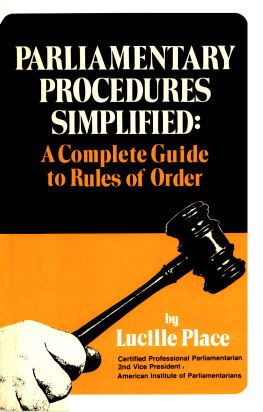
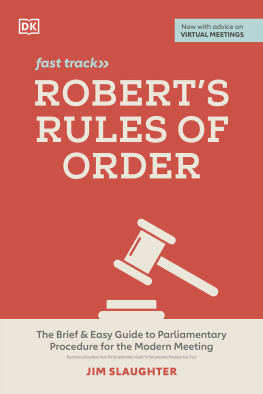
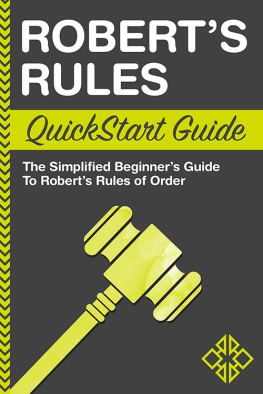
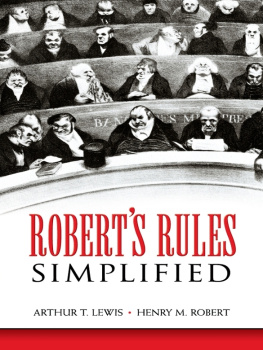
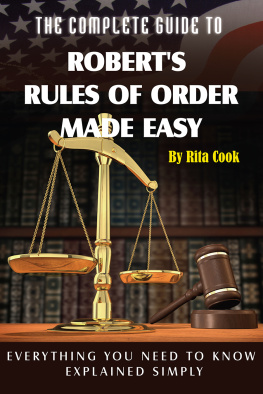

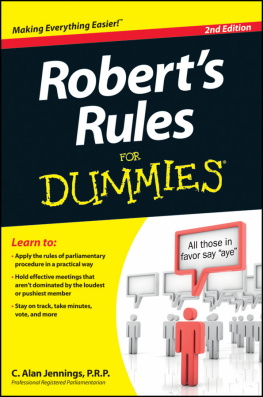


.jpg)